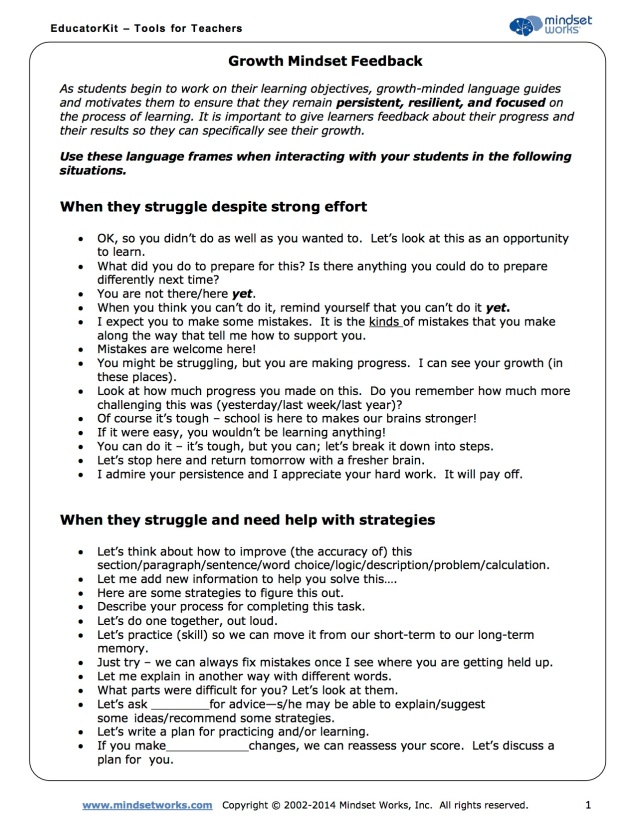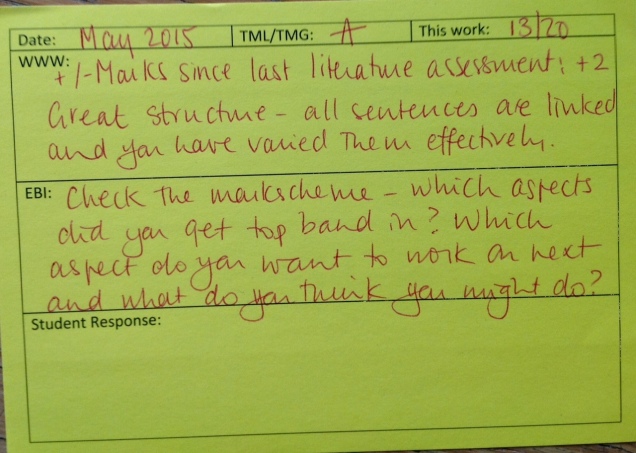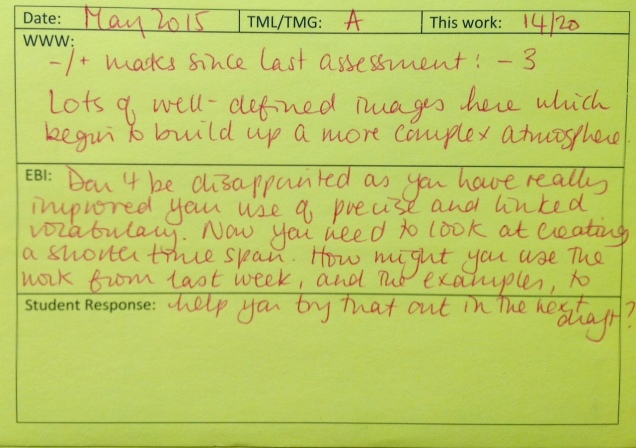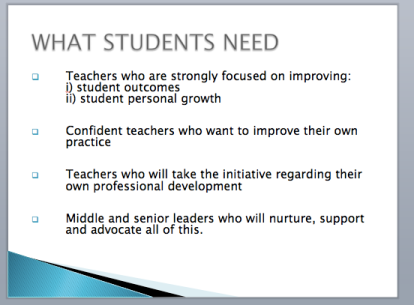Staff Choir… 🙂
Because we’re…..happy?
Last week the staff well-being group met for the first time in what seemed like five years. Actually, I think it was five years. Time flies when you’re having fun, but it also seems to fly when we’re caught up in somewhat turbulent times and wondering, as we all have done in the last couple of years, whether we’ve missed the signpost to Kansas somewhere along the way.
Strangely, the very act of meeting up as a group did us all more good than the list that we eventually came up with – 20 colleagues united in a quest to promote care and consideration for all those in our community. There were so many great ideas tumbling out one after the other – hardly a whinge, no moaning, perhaps a single almost wistful reference to focussing on the positives of what we do well a little more frequently – but the real point has to be that for some time now, we have felt as though some of the critical elements of everyone’s well-being – feeling motivated, feeling listened to, feeling supported – have been lacking. Perhaps not lost, but rather mislaid.
In a sense, it is a little bit crazy isn’t it? We shouldn’t have to plan to be nice to each other (paraphrased from our new leader 🙂 ) . We shouldn’t need protocols to listen to one another, wherever we are on the hierarchy. We don’t need permission to motivate each other, to support one another, to make each other feel as though someone’s got our back. We don’t need to fill in a form to make someone a cup of tea, do their duty or get them some throat sweets. So why in so many reports that I read is there that crushing feeling that no-one cares?
Perhaps what matters more is creating the ethos and culture where school well-being is a priority. A healthy, happy, motivated school includes everyone – staff, students, parents. With this in mind, I asked a few colleagues to tell me what they thought well-being means to them. Here are some responses:
Staff well being is every teacher driving to school with a smile, despite the challenges we know the day will inevitably bring. It is at least starting every class with a smile and a cheerful greeting for all students and colleagues. It is knowing that however awkward the days gets, we will be looked after and supported by all colleagues and most of the students. (Chris S)
Staff well being means….never having to say you’re sorry (sorry I’m being flippant in a 1970s kind of way)………..it means: Feeling you’re moving forward rather than going around in circles (Rob P)
For me, ‘staff well-being’ can be derived from how motivated the staff are. If your staff are pushing themselves, are hard working, full of ideas and engaged with their jobs then they are motivated and therefore of a positive frame of mind. I believe that being motivated makes a teacher more efficient in their role and prepared to take risks in trialling new strategies (also, happy teachers smiles making the school environment pleasant for ALL!). (Pete C)
Staff well being means recognising the importance of staff just being able to ‘be’ and spend time together. It means staff feeling that they are supported, listened to and are a collective. It also means being able to play softball. (Jenny R)
And finally (and attributed to the indomitable Ruth Urch):
First and foremost I think a happy and motivated staff promotes a happy and safe learning environment for everyone. Teachers are professionals and we should be treated as such, allow us to make decisions about what we do; support and encourage us, praise us when we do something ‘good’. Staff well being should be a whole school thing, include the support staff and anyone who contributes to school life. Promote a sense of community. Introduce events which brings everyone together other than ‘learning issues’. A few times a year, or so, let’s have something to look forward to. Something like the Wednesday twilight sessions would be good for everyone. Have a designated staff well being person or committee who is responsible to offer advice, to sound off to so that we feel looked after. Most important, probably, is that we are supported positively instead of made to feel we are failing all the time.
I think we might be on the road back to Kansas.
Seek and Ye Shall Find (or, Why I’m Not As Great As I Thought I Was)
I’ve been worrying about my Year 10 class. As they are a top set, I know that I put some pressure on them to rise above their comfort zones, refusing to teach to the lowest TG (it’s a C) and relentlessly presenting each student with my vision of a classroom utopia of achievement and success. I praise, use growth mindset language, use specific EBIs, and have a good relationship with them. To some (girls) I am like ‘an aunty’, to others (one other actually), ‘a nun’. (No, I have no idea either – it wasn’t World Book Day.) They listen and work hard. And yet.
Recently, there have been some alarm bells. Three students have come to see me asking to be moved down next year. My PP student has been looking really miserable, and doesn’t respond to cajoling, preferring to believe that she is not as good as anyone else (at all, in the school). My top top top gifted A* with-bells-on student is bored. Things clearly aren’t going so well for everyone in the class, and I don’t like it.
Our current high-priority focus on behaviour has caused many of us to re-evaluate how we interact with students, both in and out of the classroom. The tone of voice we use, the language we choose, our body language, the consequences we set and how we follow these up. These are behaviours that each one of us can model. But – there are still some classes that don’t gel, and some individuals who don’t care. How do we know what works and what doesn’t – and if we hit on something that does work, do we always know what that is? I thought what I was doing with my Year 10s was working. But did THEY think it was?
So on Friday I issued a ‘learning questionnaire’. The preamble was simple: I want you to evaluate my teaching and your learning. The rules were equally simple: be honest, take it seriously, give your name, don’t worry about my feelings, think about how you learn, think about how you’re being taught. I asked them to answer the following questions: 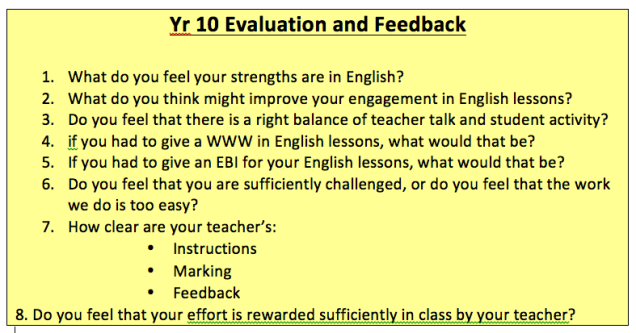 Reading through the feedback started off well, perhaps even predictably. Students feel supported. They like the buzz in the class (referred to as ‘banter’ – not sure I want to encourage that term, prefer ‘gentle teasing’ or if you’re my age, ‘ribbing’). They like/hate creative writing. They don’t feel they get enough ‘rewards’ (note to self: explain other ways of being rewarded to students – step away from the Haribo). They think the marking is thorough. Instructions are clear. I talk enough. They’d like to listen to music (second note to self: explain difference between ‘engagement’ and ‘enjoyment’).
Reading through the feedback started off well, perhaps even predictably. Students feel supported. They like the buzz in the class (referred to as ‘banter’ – not sure I want to encourage that term, prefer ‘gentle teasing’ or if you’re my age, ‘ribbing’). They like/hate creative writing. They don’t feel they get enough ‘rewards’ (note to self: explain other ways of being rewarded to students – step away from the Haribo). They think the marking is thorough. Instructions are clear. I talk enough. They’d like to listen to music (second note to self: explain difference between ‘engagement’ and ‘enjoyment’).
Then came the responses that I had been (kind of) expecting, collated below. There were several like these – perhaps just under half the class responded along similar lines.  I have to say I was shocked. Like, really shocked. I’d been observed and learning-walked with these students and – on the surface at least (hmmmm) – all had been well. What on earth were they seeing or hearing that was negative? How were they feeling so demoralised about the ability of one of their peers – and more importantly, was I doing anything that encouraged negative comparisons between them? How could the most talented student I’ve taught ‘hate literature’? Are my lessons repetitive? And… now what??
I have to say I was shocked. Like, really shocked. I’d been observed and learning-walked with these students and – on the surface at least (hmmmm) – all had been well. What on earth were they seeing or hearing that was negative? How were they feeling so demoralised about the ability of one of their peers – and more importantly, was I doing anything that encouraged negative comparisons between them? How could the most talented student I’ve taught ‘hate literature’? Are my lessons repetitive? And… now what??
Time for some bike-thinking. This is the result – some thoughts about how they think, and a few strategies I might try out. I’ll be sharing this with them on Tuesday.  The latest report on highly-pressured teenagers (article here – spoiler alert: it’s depressing) gave me further food for thought. Students at SBL don’t quite fit the profile of those in the article, but some do, and others feel pressure in so many other ways. How do we know what they are feeling when they walk through the school gates? How are our attempts to push them further and higher being perceived, if we don’t start with sharing why we are pushing them, beyond the D, or C, or A*, so that attempts to do so aren’t seen as negative, or picky? Perhaps we could develop versions of the learning questionnaire to use with some classes; it would be really useful to focus next year on what we can do to personalise our feedback to students, involving them in our teaching as much as we can. After all, how often do we share our teaching methods alongside the learning objectives? How do we know if we’re reaching them all? The best way to start – ask them.
The latest report on highly-pressured teenagers (article here – spoiler alert: it’s depressing) gave me further food for thought. Students at SBL don’t quite fit the profile of those in the article, but some do, and others feel pressure in so many other ways. How do we know what they are feeling when they walk through the school gates? How are our attempts to push them further and higher being perceived, if we don’t start with sharing why we are pushing them, beyond the D, or C, or A*, so that attempts to do so aren’t seen as negative, or picky? Perhaps we could develop versions of the learning questionnaire to use with some classes; it would be really useful to focus next year on what we can do to personalise our feedback to students, involving them in our teaching as much as we can. After all, how often do we share our teaching methods alongside the learning objectives? How do we know if we’re reaching them all? The best way to start – ask them.
EBI: growth mindset. Not just for Christmas.
 I came a bit unstuck this weekend. All my ideas about marking and feedback suddenly hit a brick wall as I realised that I was in danger of personally murdering the very yellow sticker that I feel rather responsible for. Year 10 Descriptive Writing caused me to stop and think: who am I filling this sticker out for? Once students have responded to my feedback, will I respond again? What if that needs another student response? What exactly IS the impact of triple-impact marking? And why is this post about Growth Mindset?
I came a bit unstuck this weekend. All my ideas about marking and feedback suddenly hit a brick wall as I realised that I was in danger of personally murdering the very yellow sticker that I feel rather responsible for. Year 10 Descriptive Writing caused me to stop and think: who am I filling this sticker out for? Once students have responded to my feedback, will I respond again? What if that needs another student response? What exactly IS the impact of triple-impact marking? And why is this post about Growth Mindset?
The Marking and Feedback Policy makes it clear that SBL is a school which expects students to act on the feedback of their teachers, assuming that the feedback is relevant, timely, formative, and encouraging. Both WWW and EBI are effective vehicles for this as long as the EBI is phrased as a question (or two questions) which leads to a task, which demonstrates improvement. We don’t necessarily need a sticker for this, but we do have 2 boxes of them left, and we are going to use them up. AFTER THAT, however, we will revisit how we formatively assess our students and the impact that this assessment has on their progress.
EBIs typically focus on what the student needs to do to improve. For some students in 8A in English for example, this could be:
(For the same students in 8A when I was teaching them Geography, this could be:
(jus’ sayin’)
But some students don’t need an EBI which focusses them on content or knowledge. Sometimes, their EBI needs to be a question that might help them to overcome a fixed-mindset approach to their work. One 8A student tells me daily that he ‘can’t do it’. One of my lovely PP students in top set Y10 seems overcome with an inferiority complex and constantly compares herself to the top-performing student in the same group. For those students, the feedback is more likely to be helpful, motivating, and have more impact if it is phrased without activating inadequate feelings about either ability or accomplishment.
Carole Dweck’s Mindset is a ubiquitous edu-book in every establishment, educational or otherwise, that claims to want to improve outcomes – student or otherwise. But the true power of her research lies not in what is claimed, but in how it is applied, by you, me, and the students themselves, in each of our classrooms. Below is a (rather American but we can cope) growth mindset feedback tool that might help with phrasing EBIs in ways that encourage some of our students to shed their fixed ideas about their learning (and – if I’m honest – might help US to shed OUR fixed ideas about their abilities). In next term’s twilight sessions we will look at how we can provide effective formative feedback against the backdrop of fostering a growth-mindset: take the challenge, learn from failure, continue the effort.
I then tried it out with three of the formative assessments for Yr 10 Descriptive Writing.
First thing I realised: having a TML on your sticker might not be all that helpful! The grade for the work, however, could be if it was linked to personal effort and progress. I also wondered whether phrasing EBIs in this way could develop student response in a more personalised and meaningful way – really getting them to think about how they could affect their own learning, not just leave it all to us!
Let me know what you think, or whether you already do this in your classrooms, and – especially – whether you have seen any improvements in students’ mindsets. And maybe share this with them:
There is a growth mindset framework available here, and an effort rubric available here.
2015 (because it is.)
 For the first post of the year I wanted to focus on confusion, stress, overload, that weird bonkers feeling you get by about Thursday, and a fear of getting everything wrong and nothing right – apart from the wrong things. And how about exhaustion, irritability, memory loss, acronym-overload, data-oppression and marking strain.
For the first post of the year I wanted to focus on confusion, stress, overload, that weird bonkers feeling you get by about Thursday, and a fear of getting everything wrong and nothing right – apart from the wrong things. And how about exhaustion, irritability, memory loss, acronym-overload, data-oppression and marking strain.
And now that I’ve said those things out loud, let’s move on. Yes, move right on, double-quick, don’t look back, eyes front. Because 2015 has got to be better. Not Bells And Whistles Better or Shiny New Stuff Better – just better. Systems are being developed and improved to allow us to be great in our own classrooms, teaching what we know best. We will be with our own teams, sharing ideas – old and new, developing our practice with one common purpose: to make sure that all our students can benefit from great teaching. Back to basics, and back to core values.
As part of due diligence report shared with us at the last staff meeting. Andrea outlined the immediate issues that we need to work on as a whole school. The most important slide focussed on what our students need:
With the HMI report from last month, we should feel encouraged that the strategies that we have put into place, and are developing for this year, are those which have enabled us to make reasonable progress. After these inset days, when departments and teams will regroup and re-gird (yes, I’ve just made that up – think rugby haka), we have a real opportunity to start from strengthened positions and focus on how our students learn in our classrooms.
Which brings me to my first edu-book recommendation of the year. The crashing Christmas Day realisation that I’d only read four books all year (and that was in a tent) hurtled me headlong into a pre-New Year’s resolution: Read More. After dithering with various contemporary thrillers and the new David Walliams book (are all his characters cross-dressers??), I picked up Graham Nuthall’s The Hidden Lives of Learners.
The premiss in Nuthall’s study is that just because we’re teaching, it doesn’t mean that they are learning. Vastly oversimplified as this is as a summary, the book nevertheless documents the factors both inside and out of the classroom that enable students to learn and retain concepts. The real-life transcripts of conversations with students and their teachers provide clear, sometimes funny, sometimes rather alarming, reasons why teaching the way we do doesn’t always work. It also discusses memory in detail – perhaps not new in itself, but worth considering when we have so many different abilities to cater for in the classroom . For example I have often thought that learning styles for the least able makes sense, but Nuthall states that to build memory, students need to make connections with new knowledge and known concepts. For knowledge to be retained students need “several different interactions with relevant content for that content to be processed into their working memory and integrated into their long-term memory in such a way that it becomes part of their knowledge and beliefs.”
Nuthall’s study doesn’t exactly unturn any stones. But when we are planning lessons, it might be worth remembering that ‘the way students understand tasks and how to carry them out depends on the kind of metacognitive judgements they make about the significance of the tasks and how these relate to their own abilities and knowledge’. So you might want Joe to use a geographical compass to work out where North is. But Joe knows how to use a compass because his grandad’s got a really nice one so he won’t be listening to your silly instructions. And Joe needs to make progress because he missed three weeks last term…. etc.
So this term I will be attempting to use more ‘remember when we…..’ question stems when starting lessons, or at any point where I need students to activate some prior learning, rather than just assuming that they will do it all by themselves. Of course some might need cajoling… ‘yes you remember how brilliant you were at identifying 6 causes of the English Civil War!’ (depends greatly on our own teacher-memories, mind). Because the response we all fear when we admonish students for not knowing something because ‘we only did it last term’ is …. ‘did we?’
Happy New Year everyone – here’s to a brighter 2015.
Blooms for Questioning
You may have already read this post which was published on Lightbulb in September. In the light of our impending visit, I thought it might be useful to ‘un-hide’ it! The pdf below is a fantastic resource and I’ll get some made up for each classroom.
On 3rd September I wrote:
This week’s focus is to revisit the use of Bloom’s in the classroom. Since we are making more honed use of our seating plans, to show the achievement, progress and potential of all of our students, it seems to make sense to use differentiated questioning to allow them to make that progress, whatever their level. After loads of research on various blogs, a veritable national gallery of Blooms posters and infographics, and strange you-tube clips of people who just talk a lot, I’ve found what I think might be the most useful resource for today.
Blooms’ Taxonomy Teacher Planning kit
One way in which we might start using questioning using Bloom’s more consciously could be to start writing questions into lesson plans. Take a lesson plan that you have already completed for a forthcoming lesson, take 5 students that you wish to target using focussed questioning, and write in the questions that you will ask at a given point during the lesson. If these questions are written into lesson plans, with the Bloom’s verb (lower or higher order thinking skill) clearly marked, differentiation is obvious to an observer, and all students (over the course of a series of 5 or 6 lessons) will be challenged to think beyond simple closed questions.
To make this specific to your subject, ask yourself: what do I ask questions for in class? Well duh! (you may be thinking) (or you may have switched the tab back to ebay). But answers are varied and depend on the context. How often do we simply ask questions that require recall of information? Or to bring attention back to the topic/speaker? Or that are rhetorical? (‘do you really think you should be speaking into a room fan?’). But what about these:
• engaging their interest
• challenging them to think independently
• encouraging them to explore consequences
• stimulating their ability to think creatively
• deepening and broadening their thinking, moving from concrete and factual to more analytical and evaluative
• helping them to make their own assessments and evaluations of what they have said or done
• raising their awareness of learning as a process
• helping them to make connections between different aspects of their knowledge and experience
• generating hypotheses
• bringing their attention back to the task
• encouraging them to take responsibility for their own learning
You could now select three types of questioning that you know you don’t use much, and see whether you can apply them to your students, using the Blooms’ question starters/verbs in the planning kit.
Of course once we are used to asking and varying the types of questions, we can then look at creative ways of asking students to apply their understanding – this is where the Padagogy Wheel here comes in, with its ideas for integrating the iPads with our teaching and their learning.
NB: you will notice that there is a certain confusion over Blooms’, Bloom’s, or Blooms. I have used all three. Please let me know which is the correct one.
Are they sitting comfortably? (or how to create The Ultimate Class Profile)
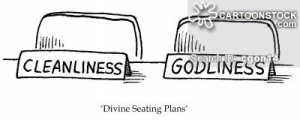 There are two types of seating plan. The first is the ‘organisational seating plan’. This is usually a plan which shows where students are sitting in the classroom, who they are next to, or which group they are in. They are usually accompanied by target grades and, if the student has a SEN status, an indication of that also. However, we are now implementing our own seating plan, the Class Profile, which, along with being the requisite document enabling us to locate our students, will be instrumental in ensuring that we are on top of the progress, achievement (over- or -under) and potential of every one of our students in each one of our classes. An über-document indeed.
There are two types of seating plan. The first is the ‘organisational seating plan’. This is usually a plan which shows where students are sitting in the classroom, who they are next to, or which group they are in. They are usually accompanied by target grades and, if the student has a SEN status, an indication of that also. However, we are now implementing our own seating plan, the Class Profile, which, along with being the requisite document enabling us to locate our students, will be instrumental in ensuring that we are on top of the progress, achievement (over- or -under) and potential of every one of our students in each one of our classes. An über-document indeed.
We finished last term by working on the class profiles for our next classes. Although the final step here will be making sure that the rooms (sometimes new – the Hub rooms for instance) are laid out appropriately, we should all be in possession of the data and information we need to create our documents. Added to the minimum requirements sent out last term, we might also now consider the next steps below them:
- The last current level/grade attained in the subject
- The target level/grade for the end of the academic year (or the aspirational 4 levels of progress that each student should reach)
- Those students who came to the school at a Level 4c (the focus of our last Review)
- All the students clearly noted who are BME, Looked After, Pupil Premium, Gifted & Talented, SEND
- A brief commentary (bullet pointed) regarding rationale for grouping within the class
Next Steps:
- Role of AC is clearly indicated
- Relationships between partners and groups are clearly indicated (eg critique, Kagan cooperative learning groups/pairs, ability)
- Extra data relevant to subject or current SOW requirements is indicated (eg English writing level for Literacy, verbal CAT score, spelling age)
- A seating plan exists for each class profile (eg class set up for independent work, class set up for groupwork)
These are clearly a step (or several) beyond the cut ‘n’ paste photo-plans of yesterterm. They will take time to create, and they will need updating over the course of the year when current levels and grades change after assessments and mocks. But they will, ultimately, make sure that not one of our students is ever forgotten, overlooked, ignored or invisible – and we can prove it too.
Of course behind the data will be the rationale for your groupings and pairings – and that narrative will be implicit in the learning taking place in your classrooms. You might use Kagan cooperative groupings, friendships (or not), ability levels, literacy levels, or the simple groupings formed from the experience you have of the class already, or of some of the individuals within it. And of course – you may switch groupings to suit your activities. What will remain though, is a class profile demonstrating your understanding of each student’s academic needs.
Here are some resources to support the creation of seating plans, and working groups in general.
http://www.classcharts.com/: Lots of people use this already (Steve Downes is an advocate) and it looks fairly straightforward
Googlesheets: Sarah Connor has an example here: https://docs.google.com/a/sbllearning.org.uk/spreadsheets/d/1d-a8qgmkFar_FLzBgGGFd6oY7lopLWL3YZU7xIiwJD8/edit#gid=196536964 and Chris Smy has an example here: https://sites.google.com/site/sblstaffmaths/home/resources (I hope these links work – email me if not!!)
Mark and Sarah will be delivering workshop sessions on googleapps for anyone who wants to create profiles using googlesheets.
Kagan structures and strategies here
Please add any of your own suggestions in the comment boxes below!



